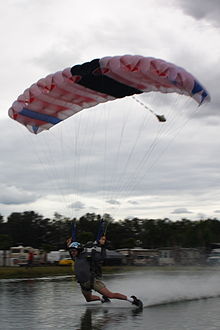Canopy piloting
This article needs additional citations for verification. (November 2018) |

Canopy piloting (also known as swooping) encompasses several disciplines, all involving the flight of a skydiving parachute.
"Swooping" is a form of canopy piloting associated with advanced skydiving. Given the close proximity to the ground during the various maneuvers, as an exhibition swooping is spectator friendly.
Records
World records that have been recorded and verified include[1]:
- G-1-f1 : Distance - General - Canopy Piloting Records : 151.95m
- Date of : 15 June 2012
- Parachutist(s): Nick Batsch (USA)
- Canopy type: Daedalus JPX Petra
- Course/place: Rockmart, GA (USA)
- G-1-f2 : Speed over a 70m course - General - Canopy Piloting Records : 2.404 sec
- Date of : 15 June 2012
- Parachutist(s): Greg Windmiller (USA)
- Canopy type: PD Velocity
- Course/place: Rockmart, GA (USA)
Contests
Pro Swooping Tour Professional competition courses mark the entry gates with wind blades stretching five feet tall, where some part of the pilot's body must break the imaginary line across the top of the entry gate pair, often only 30 feet apart. These types of landings are inherently more dangerous than normal landings. For competitors' safety, this is usually done over a "swoop pond", a shallow, artificial pond around three feet deep, that can be narrow and long.
The goal of the canopy piloting competition is to negotiate courses that challenge different performance characteristics of both canopy flight and pilot skill. Speed, distance and accuracy are just three of the basic courses used at most competitions. On a freestyle course, competitors drag through a large body of water, or touch the surface with different body parts and in different positions while maintaining nearly constant contact with the water. Gaining popularity both with competitors and spectators, freestyle puts the canopy pilot in contact with water at high speeds, increasing the risk of a violent impact.
Ground-launching and speed-flying are other forms of canopy piloting. These disciplines differ from swooping in that the canopy pilot flies his canopy in close proximity to the ground, descending a mountainside or other gradient or, in certain conditions, hovering several meters above the ground, much like a paragliding pilot. These types of descents are longer in duration.
See also
References
- ^ "Parachuting". Fai.org. Archived from the original on 29 June 2015. Retrieved 17 May 2013.
External links
- Swoop Challenge - the first professional freestyle swooping competition in the world organized in the heart of a major city
- The 2nd FAI World Championships in Canopy Piloting - 2008 at Pretoria Skydiving Club South Africa
- www.canopypiloting.com Global Swooping Community
- CanopyPiloting.net Air Sports of the third millennium
- Pro Swooping Tour
- PD Factory Team
- Account of canopy piloting student
